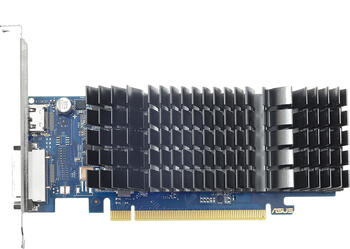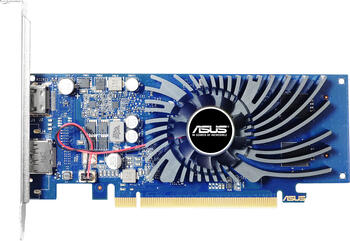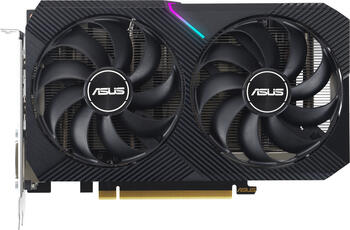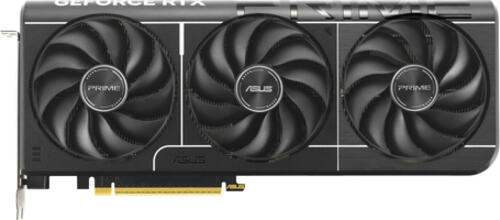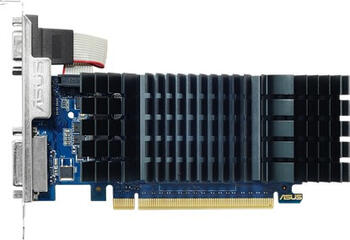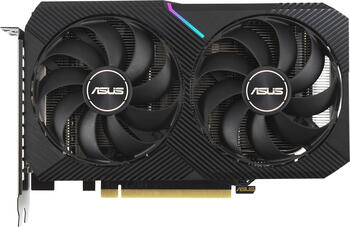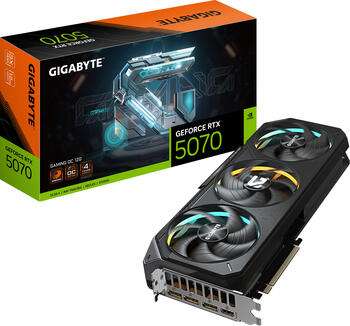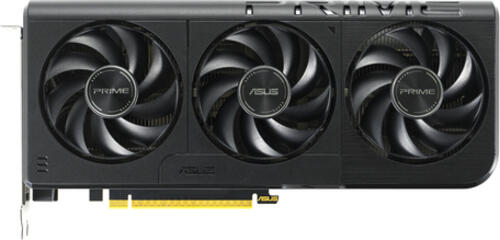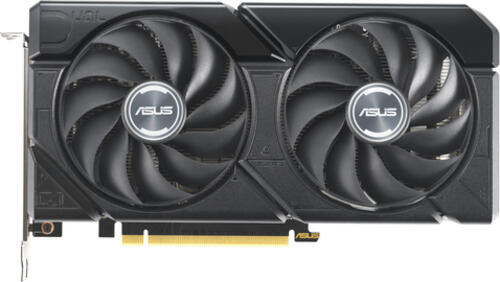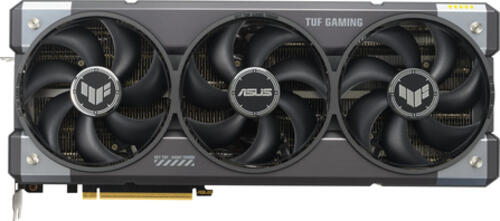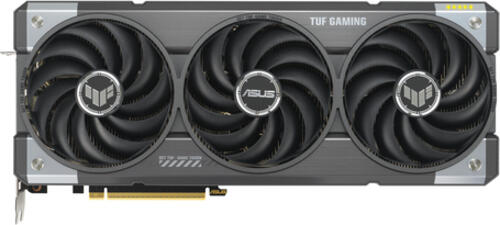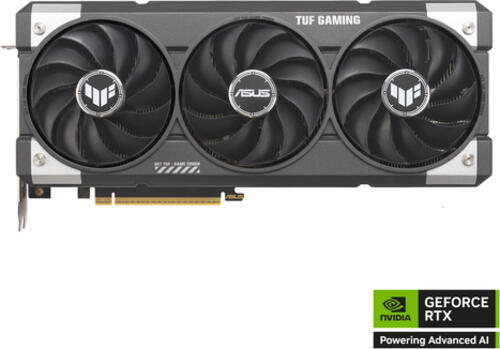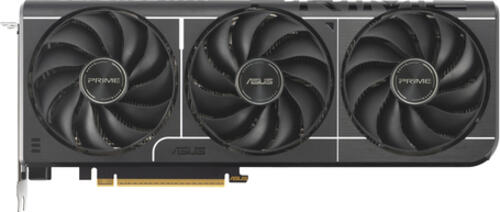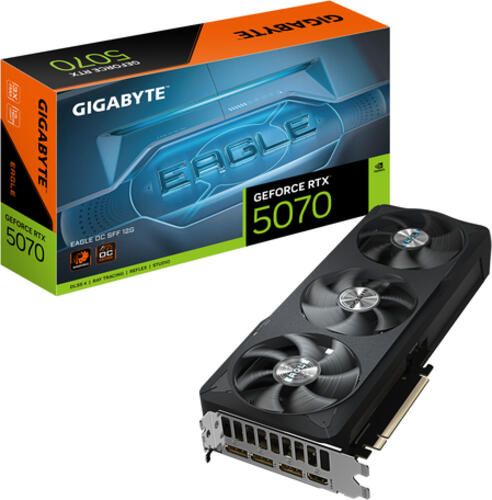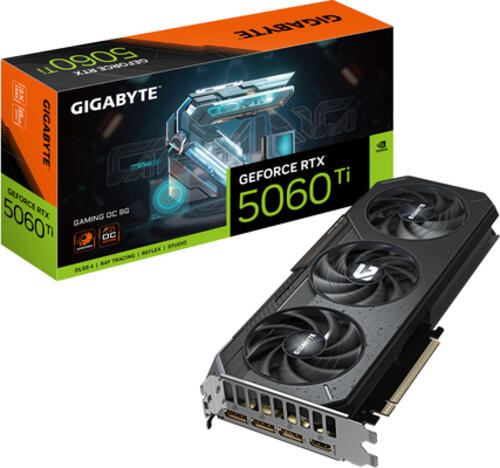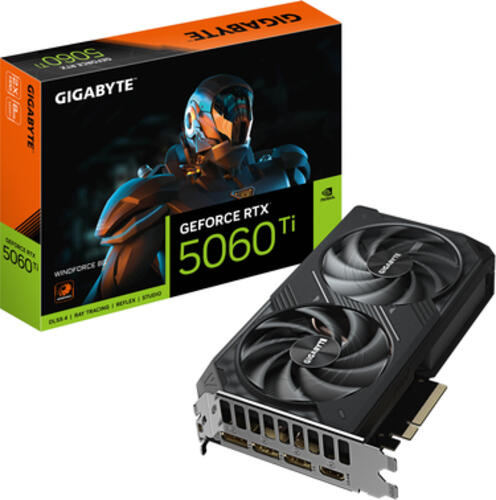- GPU: NVIDIA GeForce GT 1030
- Speicher: 2GB GDDR5, 64bit, 6Gbps, 1500MHz, 48GB/s
- Takt Basis: 1228MHz (Standard-Profil), 1266MHz (OC-Profil)
- Takt Boost: 1468MHz (Standard-Profil), 1506MHz (OC-Profil)
- Übertaktung: +38MHz Boost (OC-Profil), +39MHz Basis (OC-Profil), +1MHz Boost (Basis-Profil)
- Kühlung: Passivkühlung
- TDP/TGP: 30W (NVIDIA)
- GPU-Rechenleistung: 0.02 TFLOPS (FP16), 1.16 TFLOPS (FP32), 0.04 TFLOPS (FP64)
- Stromanschlüsse: -
- Anschlüsse: 1x DVI, 1x HDMI 2.0b
- Anbindung: PCIe 3.0 x16 (x4)
- Taktprofile (Default Mode/OC Mode), Mini-ITX-Format (&8804;185mm)
- Gesamthöhe: Dual Slot
- Bauform: PCIe-Karte (low profile)
- Slotblende: full height + low profile (Lieferumfang)
- Chip-Daten:
- Chip-Architektur: Pascal (ab 2016/Q3)
- Chip-Bezeichnung: GP108-300-A1
- Chip-Konfiguration: 3SM (384SP / 24TMU / 16ROP), 512kB L2-Cache
- Chip-Fertigung: Samsung 14nm
- Chip-Größe: 74mm, monolithisch, 1.8 Mrd. Transistoren
- Chip-Funktionen: HDCP 2.2
- API-Unterstützung: DirectX 12 (12_1) / CUDA 6.1 / Vulkan 1.3 / OpenCL 3.0 / OpenGL 4.6 / Shader Model 6.4
- Transcoding-Engine: 1x NVDEC (3rd Gen), Info
- Encoding: -
- Decoding: H.265 (8bit 4|2|0 / 10bit 4|2|0 / 12bit 4|2|0), H.264, VP9 (8bit / 10bit / 12bit), VC-1, MPEG-2, MPEG-1
- Multi-GPU-Anbindung: -
- Vorstellung (Serie): 17.05.2017, UVP| 79 USD (NVIDIA)
- Grafik: NVIDIA GeForce GT 1030 - 2GB GDDR5 - Desktop
weitere Informationen
- Modell: NVIDIA GeForce GT 1030
- Speicher: 2GB GDDR5, 64bit, 6Gbps, 1500MHz, 48GB/s
- Takt Basis: 1228MHz (Standard-Profil), 1266MHz (OC-Profil)
- Takt Boost: 1468MHz (Standard-Profil), 1506MHz (OC-Profil)
- Übertaktung: +38MHz Boost (OC-Profil), +39MHz Basis (OC-Profil), +1MHz Boost (Basis-Profil)
- Kühlung: 1x Axial-Lüfter (40mm)
- TDP/TGP: 30W (NVIDIA)
- GPU-Rechenleistung: 0.02 TFLOPS (FP16), 1.16 TFLOPS (FP32), 0.04 TFLOPS (FP64)
- Stromanschlüsse: -
- Anschlüsse: 1x HDMI 2.0b, 1x DisplayPort 1.4
- Anbindung: PCIe 3.0 x16 (x4)
- Taktprofile (Default Mode/OC Mode), Mini-ITX-Format (&8804;185mm)
- Gesamthöhe: Single Slot
- Bauform: PCIe-Karte (low profile)
- Slotblende: full height
- Chip-Daten:
- Chip-Architektur: Pascal (ab 2016/Q3)
- Chip-Bezeichnung: GP108-300-A1
- Chip-Konfiguration: 3SM (384SP / 24TMU / 16ROP), 512kB L2-Cache
- Chip-Fertigung: Samsung 14nm
- Chip-Größe: 74mm, monolithisch, 1.8 Mrd. Transistoren
- Chip-Funktionen: HDCP 2.2
- API-Unterstützung: DirectX 12 (12_1) / CUDA 6.1 / Vulkan 1.3 / OpenCL 3.0 / OpenGL 4.6 / Shader Model 6.4
- Transcoding-Engine: 1x NVDEC (3rd Gen), Info
- Encoding: -
- Decoding: H.265 (8bit 4|2|0 / 10bit 4|2|0 / 12bit 4|2|0), H.264, VP9 (8bit / 10bit / 12bit), VC-1, MPEG-2, MPEG-1
- Multi-GPU-Anbindung: -
- Vorstellung (Serie): 17.05.2017, UVP| 79 USD (NVIDIA)
- Grafik: NVIDIA GeForce GT 1030 - 2GB GDDR5 - Desktop
weitere Informationen
- GPU: NVIDIA GeForce RTX 3050
- Speicher: 8GB GDDR6, 128bit, 14Gbps, 1750MHz, 224GB/s
- Takt Basis: 1552MHz (Standard-Profil), 1552MHz (OC-Profil)
- Takt Boost: 1822MHz (Standard-Profil), 1852MHz (OC-Profil)
- Übertaktung: +75MHz Boost (OC-Profil), +45MHz Boost (Standard-Profil)
- Kühlung: 2x Axial-Lüfter (95mm) mit 0dB-Zero-Fan-Modus (bis 50C)
- TDP/TGP: 130W (NVIDIA)
- AI-Rechenleistung: 73 TOPS
- GPU-Rechenleistung: 9.48 TFLOPS (FP16), 9.48 TFLOPS (FP32), 0.15 TFLOPS (FP64)
- Stromanschlüsse: 1x 6-Pin PCIe
- Anschlüsse: 1x DVI, 1x HDMI 2.1, 1x DisplayPort 1.4a
- Anbindung: PCIe 4.0 x16 (x8)
- AI-Beschleunigung, Taktprofile (Default Mode/OC Mode), LED-Beleuchtung (blau/violett), Backplate, mit LHR (Lite Hash Rate)
- Gesamthöhe: Dual Slot (2 Slots)
- Bauform: PCIe-Karte (full height)
- Slotblende: full height
- Chip-Daten:
- Chip-Architektur: Ampere (ab 2020/Q3)
- Chip-Bezeichnung: GA106-150-KA-A1
- Chip-Konfiguration: 20SM (2560SP / 80TMU / 32ROP), 20 RT Cores, 80 Tensor Cores, 2MB L2-Cache
- Chip-Fertigung: Samsung 8nm
- Chip-Größe: 276mm, monolithisch, 12 Mrd. Transistoren
- Chip-Funktionen: Raytracing (2nd Gen NVIDIA RTX), NVIDIA Tensor (3rd Gen), HDCP 2.3
- API-Unterstützung: DirectX 12 Ultimate (12_2) / CUDA 8.6 / Vulkan 1.3 / OpenCL 3.0 / OpenGL 4.6 / Shader Model 6.7
- Transcoding-Engine: 1x NVENC (7th Gen, max. Sessions| 8), 1x NVDEC (5th Gen), Info
- Encoding: H.265 (4K YUV 4|2|0 / 4K YUV 4|4|4 / 4K Lossless / 8K / HEVC 10bit support / HEVC B Frame support), H.264 (YUV 4|2|0 / YUV 4|4|4 / Lossless)
- Decoding: AV1 (8bit / 10bit), H.265 (8bit 4|2|0 / 10bit 4|2|0 / 12bit 4|2|0 / 8bit 4|4|4 / 10bit 4|4|4 / 12bit 4|4|4), H.264, VP9 (8bit / 10bit / 12bit), VP8, VC-1, MPEG-2, MPEG-1
- Multi-GPU-Anbindung: -
- Vorstellung (Serie): 04.01.2022, UVP| 249 USD (NVIDIA)
- Grafik: NVIDIA GeForce RTX 3050 - 8GB GDDR6 - Desktop
weitere Informationen
ASUS Prime -RTX5070-O12G. Grafikprozessorenfamilie: NVIDIA, GPU: GeForce RTX 5070. Separater Grafik-Adapterspeicher: 12 GB, Grafikkartenspeichertyp: GDDR7, Breite der Speicherschnittstelle: 192 Bit. Maximale Auflösung: 7680 x 4320 Pixel. DirectX-Version: 12 Ultimate, OpenGL-Version: 4.6. Schnittstelle: PCI Express 5.0. Kühlung: Aktiv, Anzahl Lüfter: 3 Lüfter
- Modell: NVIDIA GeForce GT 730
- Speicher: 2GB GDDR5, 64bit, 5Gbps, 1250MHz, 40GB/s
- Takt Basis: 902MHz
- Takt Boost: unbekannt
- Übertaktung: -
- Kühlung: Passivkühlung
- TDP/TGP: 38W (NVIDIA)
- Stromanschlüsse: -
- Anschlüsse: 1x VGA, 1x DVI, 1x HDMI 1.4a
- Anbindung: PCIe 2.0 x16 (x8)
- Mini-ITX-Format (&8804;185mm)
- Gesamthöhe: Dual Slot
- Bauform: PCIe-Karte (low profile)
- Slotblende: full height
- Chip-Daten:
- Chip-Architektur: Kepler 2.0 (ab 2013/Q2)
- Chip-Bezeichnung: GK208-302-B1
- Chip-Konfiguration: 2SMX (384SP / 32TMU / 8ROP), 128kB L2-Cache
- Chip-Fertigung: TSMC 28nm
- Chip-Größe: 87mm, monolithisch, 915 Mio. Transistoren
- API-Unterstützung: DirectX 12 (11_0) / CUDA 3.5 / Vulkan 1.3 / OpenCL 3.0 / OpenGL 4.6 / Shader Model 5.1
- Transcoding-Engine: Info
- Encoding: -
- Decoding: -
- Multi-GPU-Anbindung: -
- Vorstellung (Serie): 18.06.2014
- Grafik: NVIDIA GeForce GT 730 - 2GB GDDR5 - Desktop
weitere Informationen
- Modell: NVIDIA GeForce RTX 3060 (GA104)
- Speicher: 12GB GDDR6, 192bit, 15Gbps, 1875MHz, 360GB/s
- Takt Basis: 1320MHz (Standard-Profil), 1320MHz (OC-Profil)
- Takt Boost: 1837MHz (Standard-Profil), 1867MHz (OC-Profil)
- Übertaktung: +90MHz Boost (OC-Profil), +60MHz Boost (Standard-Profil)
- Kühlung: 2x Axial-Lüfter (95mm) mit 0dB-Zero-Fan-Modus (bis 55C)
- TDP/TGP: 170W (NVIDIA)
- AI-Rechenleistung: +102 TOPS
- GPU-Rechenleistung: 13.38 TFLOPS (FP16), 13.38 TFLOPS (FP32), 0.21 TFLOPS (FP64)
- Stromanschlüsse: 1x 8-Pin PCIe
- Anschlüsse: 1x HDMI 2.1, 3x DisplayPort 1.4a
- Anbindung: PCIe 4.0 x16
- AI-Beschleunigung, Taktprofile (Default Mode/OC Mode), LED-Beleuchtung (blau/violett), Backplate, mit LHR (Lite Hash Rate)
- Gesamthöhe: Dual Slot (2 Slots)
- Bauform: PCIe-Karte (full height)
- Slotblende: full height
- Chip-Daten:
- Chip-Architektur: Ampere (ab 2020/Q3)
- Chip-Bezeichnung: GA104-150-KC-A1
- Chip-Konfiguration: 28SM (3584SP / 112TMU / 64ROP), 28 RT Cores, 112 Tensor Cores, 3MB L2-Cache
- Chip-Fertigung: Samsung 8nm
- Chip-Größe: 392mm, monolithisch, 17.4 Mrd. Transistoren
- Chip-Funktionen: Raytracing (2nd Gen NVIDIA RTX), NVIDIA Tensor (3rd Gen), HDCP 2.3
- API-Unterstützung: DirectX 12 Ultimate (12_2) / CUDA 8.6 / Vulkan 1.3 / OpenCL 3.0 / OpenGL 4.6 / Shader Model 6.7
- Transcoding-Engine: 1x NVENC (7th Gen, max. Sessions| 8), 1x NVDEC (5th Gen), Info
- Encoding: H.265 (4K YUV 4|2|0 / 4K YUV 4|4|4 / 4K Lossless / 8K / HEVC 10bit support / HEVC B Frame support), H.264 (YUV 4|2|0 / YUV 4|4|4 / Lossless)
- Decoding: AV1 (8bit / 10bit), H.265 (8bit 4|2|0 / 10bit 4|2|0 / 12bit 4|2|0 / 8bit 4|4|4 / 10bit 4|4|4 / 12bit 4|4|4), H.264, VP9 (8bit / 10bit / 12bit), VP8, VC-1, MPEG-2, MPEG-1
- Multi-GPU-Anbindung: -
- Vorstellung (Serie): 01.09.2021, UVP| 329 USD (NVIDIA)
- Grafik: NVIDIA GeForce RTX 3060 - 12GB GDDR6 - Desktop (GA104)
weitere Informationen
- GPU: NVIDIA GeForce RTX 3050
- Speicher: 6GB GDDR6, 96bit, 14Gbps, 1750MHz, 168GB/s
- Takt Basis: 1042MHz (Standard-Profil), 1042MHz (OC-Profil)
- Takt Boost: 1507MHz (Standard-Profil), 1537MHz (OC-Profil)
- Übertaktung: +67MHz Boost (OC-Profil), +37MHz Boost (Standard-Profil)
- Kühlung: 2x Axial-Lüfter (95mm)
- TDP/TGP: 70W (NVIDIA)
- AI-Rechenleistung: 73 TOPS
- GPU-Rechenleistung: 7.08 TFLOPS (FP16), 7.08 TFLOPS (FP32), 0.11 TFLOPS (FP64)
- Stromanschlüsse: -
- Anschlüsse: 1x DVI, 1x HDMI 2.1, 1x DisplayPort 1.4a
- Anbindung: PCIe 4.0 x16 (x8)
- AI-Beschleunigung, Taktprofile (Default Mode/OC Mode), ohne LHR (Lite Hash Rate)
- Gesamthöhe: Dual Slot (2 Slots)
- Bauform: PCIe-Karte (full height)
- Slotblende: full height
- Chip-Daten:
- Chip-Architektur: Ampere (ab 2020/Q3)
- Chip-Bezeichnung: GA107-325-K2-A1
- Chip-Konfiguration: 18SM (2304SP / 72TMU / 32ROP), 18 RT Cores, 72 Tensor Cores, 2MB L2-Cache
- Chip-Fertigung: Samsung 8nm
- Chip-Größe: 200mm, monolithisch, 8.7 Mrd. Transistoren
- Chip-Funktionen: Raytracing (2nd Gen NVIDIA RTX), NVIDIA Tensor (3rd Gen), HDCP 2.3
- API-Unterstützung: DirectX 12 Ultimate (12_2) / CUDA 8.6 / Vulkan 1.3 / OpenCL 3.0 / OpenGL 4.6 / Shader Model 6.7
- Transcoding-Engine: 1x NVENC (7th Gen, max. Sessions| 8), 1x NVDEC (5th Gen), Info
- Encoding: H.265 (4K YUV 4|2|0 / 4K YUV 4|4|4 / 4K Lossless / 8K / HEVC 10bit support / HEVC B Frame support), H.264 (YUV 4|2|0 / YUV 4|4|4 / Lossless)
- Decoding: AV1 (8bit / 10bit), H.265 (8bit 4|2|0 / 10bit 4|2|0 / 12bit 4|2|0 / 8bit 4|4|4 / 10bit 4|4|4 / 12bit 4|4|4), H.264, VP9 (8bit / 10bit / 12bit), VP8, VC-1, MPEG-2, MPEG-1
- Multi-GPU-Anbindung: -
- Vorstellung (Serie): 02.02.2024, UVP| 179 USD (NVIDIA)
- Grafik: NVIDIA GeForce RTX 3050 - 6GB GDDR6 - Desktop
weitere Informationen
- Modell: NVIDIA GeForce RTX 5070
- Speicher: 12GB GDDR7, 192bit, 28Gbps, 1750MHz, 672GB/s
- Takt Basis: 2116MHz
- Takt Boost: 2625MHz
- Übertaktung: +115MHz Boost
- Kühlung: 3x Axial-Lüfter mit 0dB-Zero-Fan-Modus
- TDP/TGP: 250W (NVIDIA)
- AI-Rechenleistung (INT8): >494 TOPS
- GPU-Rechenleistung: 32.26 TFLOPS (FP16), 32.26 TFLOPS (FP32), 0.5 TFLOPS (FP64)
- Stromanschlüsse: 1x 12V-2x6 (via Adapter| 2x 8-Pin PCIe)
- Anschlüsse: 1x HDMI 2.1b, 3x DisplayPort 2.1b UHBR20
- Anbindung: PCIe 5.0 x16
- AI-Beschleunigung, LED-Beleuchtung (RGB, Lüfter RGB beleuchtet), Backplate, Dual BIOS Switch, Grafikkarten-Halterung
- Gesamthöhe: Triple Slot
- Bauform: PCIe-Karte (full height)
- Slotblende: full height
- Chip-Daten:
- Chip-Architektur: Blackwell (ab 2025/Q1)
- Chip-Bezeichnung: GB205-300
- Chip-Konfiguration: 48SM (6144SP / 192TMU / 64ROP), 48 RT Cores, 192 Tensor Cores, 40MiB L2-Cache
- Chip-Fertigung: TSMC 5nm NVIDIA 4N
- Chip-Größe: 263mm², monolithisch, 31 Mrd. Transistoren
- Chip-Funktionen: Raytracing (4th Gen NVIDIA RTX, 94 TFLOPS), NVIDIA Tensor (5th Gen, 494 TOPS), HDCP 2.3
- API-Unterstützung: DirectX 12 Ultimate (12_2) / CUDA 12.8 / Vulkan 1.3 / OpenCL 3.0 / OpenGL 4.6 / Shader Model 6.8
- Transcoding-Engine: 1x NVENC (9th Gen, max. Sessions| 8), 1x NVDEC (6th Gen), Info
- Encoding: AV1, H.265 (4K YUV 4|2|0 / 4K YUV 4|4|4 / 4K Lossless / 8K / HEVC 10bit support / HEVC B Frame support), H.264 (YUV 4|2|0 / YUV 4|4|4 / Lossless)
- Decoding: AV1 (8bit / 10bit), H.265 (8bit 4|2|0 / 10bit 4|2|0 / 12bit 4|2|0 / 8bit 4|4|4 / 10bit 4|4|4 / 12bit 4|4|4), H.264, VP9 (8bit / 10bit / 12bit), VP8, VC-1, MPEG-2, MPEG-1
- Multi-GPU-Anbindung: -
- Vorstellung (Serie): 06.01.2025, Marktstart| 02.2025, UVP| 549 USD/649 EUR (NVIDIA)
- Grafik: NVIDIA GeForce RTX 5070 - 12GB GDDR7 - Desktop
weitere Informationen
ASUS Prime -RTX5060-O8G. Grafikprozessorenfamilie: NVIDIA, GPU: GeForce RTX 5060. Separater Grafik-Adapterspeicher: 8 GB, Grafikkartenspeichertyp: GDDR7, Breite der Speicherschnittstelle: 128 Bit. Maximale Auflösung: 7680 x 4320 Pixel. OpenGL-Version: 4.6. Schnittstelle: PCI Express 5.0. Kühlung: Aktiv, Anzahl Lüfter: 3 Lüfter
ASUS Dual -RTX4060TI-O8G-EVO. Grafikprozessorenfamilie: NVIDIA, GPU: GeForce RTX 4060 Ti. Separater Grafik-Adapterspeicher: 8 GB, Grafikkartenspeichertyp: GDDR6, Breite der Speicherschnittstelle: 128 Bit. Maximale Auflösung: 7680 x 4320 Pixel. DirectX-Version: 12 Ultimate, OpenGL-Version: 4.6. Schnittstelle: PCI Express 4.0. Kühlung: Aktiv, Anzahl Lüfter: 2 Lüfter
ASUS TUF Gaming TUF-RTX5080-O16G-GAMING. Grafikprozessorenfamilie: NVIDIA, GPU: GeForce RTX 5080. Separater Grafik-Adapterspeicher: 16 GB, Grafikkartenspeichertyp: GDDR7, Breite der Speicherschnittstelle: 256 Bit. Maximale Auflösung: 7680 x 4320 Pixel. OpenGL-Version: 4.6. Schnittstelle: PCI Express 5.0. Kühlung: Aktiv, Anzahl Lüfter: 3 Lüfter, Farben der Beleuchtung: Multi
ASUS TUF Gaming TUF-RTX5070TI-O16G-GAMING. Grafikprozessorenfamilie: NVIDIA, GPU: GeForce RTX 5070 Ti. Separater Grafik-Adapterspeicher: 16 GB, Grafikkartenspeichertyp: GDDR7, Breite der Speicherschnittstelle: 256 Bit. Maximale Auflösung: 7680 x 4320 Pixel. DirectX-Version: 12 Ultimate, OpenGL-Version: 4.6. Schnittstelle: PCI Express 5.0. Kühlung: Aktiv, Anzahl Lüfter: 3 Lüfter, Farben der Beleuchtung: Multi
ASUS TUF Gaming TUF-RTX5060TI-O16G-GAMING. Grafikprozessorenfamilie: NVIDIA, GPU: GeForce RTX 5060 Ti. Separater Grafik-Adapterspeicher: 16 GB, Grafikkartenspeichertyp: GDDR7, Breite der Speicherschnittstelle: 128 Bit. Maximale Auflösung: 7680 x 4320 Pixel. OpenGL-Version: 4.6. Schnittstelle: PCI Express 5.0. Kühlung: Aktiv, Anzahl Lüfter: 3 Lüfter, Farben der Beleuchtung: Multi
ASUS Prime -RTX5060TI-O16G. Grafikprozessorenfamilie: NVIDIA, GPU: GeForce RTX 5060 Ti. Separater Grafik-Adapterspeicher: 16 GB, Grafikkartenspeichertyp: GDDR7, Breite der Speicherschnittstelle: 128 Bit. Maximale Auflösung: 7680 x 4320 Pixel. OpenGL-Version: 4.6. Schnittstelle: PCI Express 5.0. Kühlung: Aktiv, Anzahl Lüfter: 3 Lüfter
GIGABYTE GeForce RTX 5080 GAMING OC 16G Grafikkarte - 16GB GDDR7, 256 Bit, PCI-E 5.0, 2730MHz Core Clock, 3 x DisplayPort, 1 x HDMI, GV-N5080GAMING OC-16GD. Grafikprozessorenfamilie: NVIDIA, GPU: GeForce RTX 5080, Prozessortaktfrequenz: 2730 MHz. Separater Grafik-Adapterspeicher: 16 GB, Grafikkartenspeichertyp: GDDR7, Breite der Speicherschnittstelle: 256 Bit, Speichertaktfrequenz: 28000 MHz. Maximale Auflösung: 7680 x 4320 Pixel. DirectX-Version: 12.0, OpenGL-Version: 4.6. Schnittstelle: PCI Express 5.0. Kühlung: Aktiv, Anzahl Lüfter: 3 Lüfter, Farben der Beleuchtung: Multi
GIGABYTE GeForce RTX 5070 EAGLE OC SFF 12G Grafikkarte - 12GB GDDR7, 192 Bit, PCI-E 5.0, 2587 MHz Core Clock, 3 x DP 2.1a, 1 x HDMI 2.1b, NVIDIA DLSS 4, GV-N5070GAMING OC-12GD. Grafikprozessorenfamilie: NVIDIA, GPU: GeForce RTX 5070, Prozessortaktfrequenz: 2587 MHz. Separater Grafik-Adapterspeicher: 12 GB, Grafikkartenspeichertyp: GDDR7, Breite der Speicherschnittstelle: 192 Bit, Speichertaktfrequenz: 28000 MHz. Maximale Auflösung: 7680 x 4320 Pixel. DirectX-Version: 12.0, OpenGL-Version: 4.6. Schnittstelle: PCI Express x16 5.0. Kühlung: Aktiv, Anzahl Lüfter: 3 Lüfter
GIGABYTE GeForce RTX 5070 WINDFORCE OC SFF 12G Grafikkarte - 12GB GDDR7, 192 Bit, PCI-E 5.0, 2542 MHz Core Clock, 3 x DP 2.1a, 1 x HDMI 2.1b, NVIDIA DLSS 4, GV-N5070WF3OC-12GD. Grafikprozessorenfamilie: NVIDIA, GPU: GeForce RTX 5070, Prozessortaktfrequenz: 2542 MHz. Separater Grafik-Adapterspeicher: 12 GB, Grafikkartenspeichertyp: GDDR7, Breite der Speicherschnittstelle: 192 Bit, Speichertaktfrequenz: 28000 MHz. Maximale Auflösung: 7680 x 4320 Pixel. DirectX-Version: 12.0, OpenGL-Version: 4.6. Schnittstelle: PCI Express x16 5.0. Kühlung: Aktiv, Anzahl Lüfter: 3 Lüfter
GIGABYTE GeForce RTX 5060 Ti EAGLE OC 16G Grafikkarte – 16 GB GDDR7, 128 Bit, PCI-E 5.0, 2617 MHz Kernfrequenz, 3 x DisplayPort, 1 x HDMI, GV-N506TEAGLE OC-16GD. Grafikprozessorenfamilie: NVIDIA, GPU: GeForce RTX 5060 Ti, Prozessortaktfrequenz: 2617 MHz. Separater Grafik-Adapterspeicher: 16 GB, Grafikkartenspeichertyp: GDDR7, Breite der Speicherschnittstelle: 128 Bit, Speichertaktfrequenz: 28000 MHz. Maximale Auflösung: 7680 x 4320 Pixel. DirectX-Version: 12.0, OpenGL-Version: 4.6. Schnittstelle: PCI Express x16 5.0. Kühlung: Aktiv, Anzahl Lüfter: 2 Lüfter
GIGABYTE GeForce RTX 5060 Ti GAMING OC 8G Grafikkarte – 8 GB GDDR7, 128 Bit, PCI-E 5.0, 2647 MHz Kernfrequenz, 3 x DisplayPort, 1 x HDMI, GV-N506TGAMING OC-8GD. Grafikprozessorenfamilie: NVIDIA, GPU: GeForce RTX 5060 Ti, Prozessortaktfrequenz: 2647 MHz. Separater Grafik-Adapterspeicher: 8 GB, Grafikkartenspeichertyp: GDDR7, Breite der Speicherschnittstelle: 128 Bit, Speichertaktfrequenz: 28000 MHz. Maximale Auflösung: 7680 x 4320 Pixel. DirectX-Version: 12.0, OpenGL-Version: 4.6. Schnittstelle: PCI Express x16 5.0. Kühlung: Aktiv, Anzahl Lüfter: 3 Lüfter
GIGABYTE GeForce RTX 5060 Ti WINDFORCE 8G Grafikkarte – 8 GB GDDR7, 128 Bit, PCI-E 5.0, 2572 MHz Kernfrequenz, 3 x DisplayPort, 1 x HDMI, GV-N506TWF2-8GD. Grafikprozessorenfamilie: NVIDIA, GPU: GeForce RTX 5060 Ti, Prozessortaktfrequenz: 2572 MHz. Separater Grafik-Adapterspeicher: 8 GB, Grafikkartenspeichertyp: GDDR7, Breite der Speicherschnittstelle: 128 Bit, Speichertaktfrequenz: 28000 MHz. Maximale Auflösung: 7680 x 4320 Pixel. DirectX-Version: 12.0, OpenGL-Version: 4.6. Schnittstelle: PCI Express x16 5.0. Kühlung: Aktiv, Anzahl Lüfter: 2 Lüfter
Die Kategorie "NVidia PCIexpress Grafikkarte" umfasst eine Auswahl an Grafikkarten des Herstellers NVidia, die über eine PCI Express-Schnittstelle an den Computer angeschlossen werden. Hier sind einige wichtige Informationen zur Kategorie "NVidia PCIexpress Grafikkarte":
1. NVidia Grafikkarten: NVidia ist einer der führenden Hersteller von Grafikkarten und bekannt für seine leistungsstarken GPUs (Graphics Processing Units). NVidia bietet eine breite Palette von Grafikkarten für verschiedene Anwendungen an, darunter Gaming, professionelle Grafikdesign, 3D-Modellierung, Videobearbeitung und mehr.
2. PCI Express-Schnittstelle: Die Grafikkarten in dieser Kategorie nutzen die PCI Express-Schnittstelle, die heutzutage die gängigste Verbindungsmethode für Grafikkarten ist. PCI Express bietet hohe Bandbreite und ermöglicht eine effiziente Datenübertragung zwischen der Grafikkarte und dem Motherboard des Computers.
3. Leistungsmerkmale: Die NVidia Grafikkarten bieten verschiedene Leistungsmerkmale wie GPU-Takt, Anzahl der CUDA-Kerne (parallel arbeitende Prozessoren), Grafikspeichergröße, Speichertyp (GDDR5, GDDR6 usw.), Anschlussmöglichkeiten (HDMI, DisplayPort, DVI, VGA usw.) und unterstützte Auflösungen. Die Leistungsfähigkeit variiert je nach Modell und richtet sich nach den Anforderungen der jeweiligen Anwendung.
4. Gaming- und Multimedia-Erlebnis: NVidia Grafikkarten sind für Gaming-Enthusiasten besonders interessant, da sie hochwertige Grafik- und Videoverarbeitungsfähigkeiten bieten. Sie ermöglichen ein reibungsloses Gameplay, hohe Bildraten, realistische Texturen und visuell beeindruckende Effekte. Sie sind auch für die Wiedergabe von hochauflösenden Videos und die Bearbeitung von Multimedia-Inhalten geeignet.
5. Treiber und Software: NVidia bietet regelmäßige Treiber- und Softwareupdates für seine Grafikkarten an, um die Leistung zu optimieren, neue Funktionen hinzuzufügen und Kompatibilität mit aktuellen Spielen und Anwendungen zu gewährleisten. Es ist wichtig, die neuesten Treiber von der NVidia-Website herunterzuladen und zu installieren, um das beste aus Ihrer Grafikkarte herauszuholen.
Beim Kauf einer NVidia PCIexpress Grafikkarte ist es wichtig, die technischen Spezifikationen, die Leistungsfähigkeit und die Kompatibilität mit Ihrem Computersystem und den Anforderungen Ihrer Anwendungen zu berücksichtigen. Lesen Sie auch Kundenbewertungen und Empfehlungen, um sich über die Erfahrungen anderer Benutzer mit der jeweiligen Grafikkarte zu informieren.
